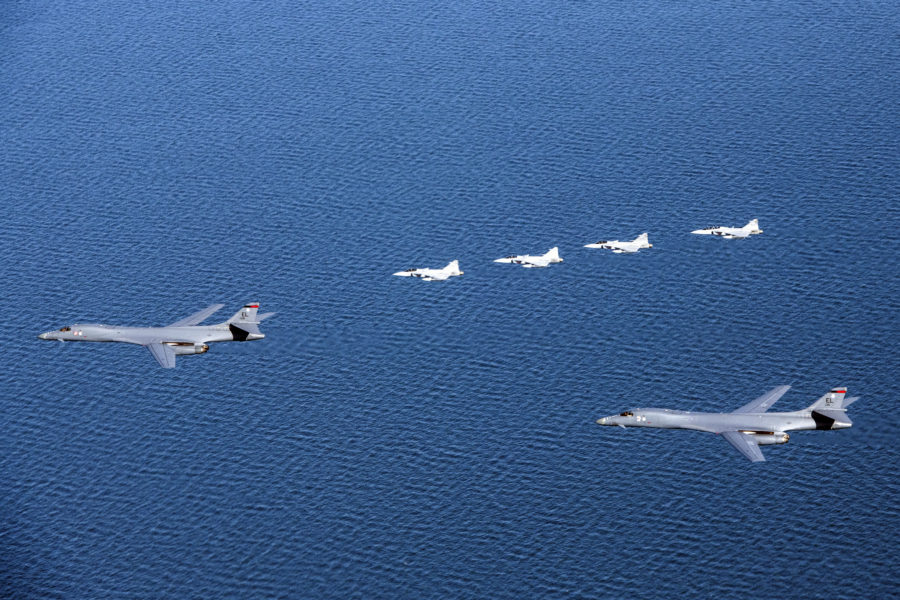If Finland and Sweden are admitted to NATO, they would make a huge contribution to the alliance and exact only a small additional investment from the U.S., Gen. Christopher G. Cavoli told the Senate Armed Services Committee.
In his confirmation hearing to be Supreme Allied Commander, Europe, Cavoli, head of U.S. Army forces in Europe, was asked if, in his professional military opinion, adding Finland and Sweden would be a net gain for NATO. He answered that, “I look forward to the accession of Finland and Sweden to the alliance from the military perspective.”
Each of those countries’ militaries “brings quite a bit of capability and capacity to the alliance from Day One,” he said, asserting that Finland’s army is “large, … well equipped, very well trained, very quickly [expandable], exercised very frequently, and absolutely expert in defending” its border with Russia.
Sweden has a growing military—whose ground forces will increase by a third in the next few years—and it has a large and capable naval fleet, with ports on the Baltic Sea, Cavoli said.
The addition of these two countries would mean “the entire [Baltic] Sea, with the exception of … a few kilometers, will be the coastline of NATO nations, which will create a very different geometry in the area,” he pointed out.
This fact creates an “almost geometric” increase in dilemmas for the Russians, Cavoli said, which it does not now have to deal with, “as they sail forth from St. Petersburg and Kaliningrad. So it will be advantageous.”
Finland has a history of defending itself against Russia in the “Winter War” of 1939, when that country repelled a Soviet invasion with much smaller forces, across an 800-mile-long border, Cavoli noted.
“That Winter War is studied not just by western armies, but as a model of how to beat a larger force, studied by the Russians as an important lesson to learn from their past,” Cavoli said.
Asked by Sen. Tom Cotton (R-Ark.) if Finland represents a “hot stove” the Russians would not want to touch, Cavoli said “I wouldn’t want to do it if I were them.”
Russia “has not put too many ground forces on that border. It’s been an ‘economy-of-force theater’ for them, because they thought they had a relationship with Finland that allowed them to do that. This allowed Russia to concentrate ground forces in other places. That possibility will now go away for Russia,” Cavoli said, indicating that Russia will have to spread its forces over a wider area to match NATO.
“In addition to that, the Finns … are absolutely expert in defending that border,” Cavoli said, noting that he had made a snowmobile trip with the head of the Finish army along most of the frontier and admired the preparations and fortifications there.
In the air domain, Cavoli said Finland has American fighter jets—he misspoke, saying Finland has F-15s when in fact, it has F/A-18s—and has signed up to buy 64 F-35 fighters, “so they will arrive bringing capacity and capability.”
Cavoli said his Swedish counterpart, Gen. Karl Engelbrektson, is approved for “a 200-percent increase in his acquisition budget over a five-year period,” and Sweden is in the process of integrating Patriot air defense missiles into their portfolio; the first battery is already in place, he noted.
Sweden’s navy in the Baltic will also be “of enormous military significance to the alliance,” Cavoli said. The island of Gotland, which is Swedish territory, is an “unsinkable aircraft carrier” in the region. He also praised Sweden’s underwater and submarine capabilities.
The two countries could easily be integrated into the NATO command structure, Cavoli said, noting that the U.S. and NATO conduct numerous exercises with both countries, and there is common equipment and operational concepts. Besides Cavoli’s own Army component, U.S. Air Forces in Europe and U.S. Naval Forces, Europe, “do this all the time, as well.”
“We do exercises with Finland. I’ve got Soldiers in Finland right now,” Cavoli noted. “We just brought a couple of Stryker companies back out of there, and we’ve got a parachute battalion going up there this summer. We exercise frequently with Sweden, to include high-end air and missile defense.”
Cavoli thinks “it will be quite easy to integrate them quickly. We’ve been integrating them in our large-scale exercises as well as our operations abroad for some years, now.”
He said Sweden has agreed to up its defense spending to two percent of GDP by 2028, but the Swedish army chief has told him Sweden will more likely “get there by 2024.”
Sweden has adopted “a model of 3, 2, 1,” Cavoli explained.
“Go up to three brigades, which is adding an additional brigade—that’s adding a big chunk of it right there—The second part is to add high-end capabilities, so, the purchase of Patriot, which my command is helping them integrate into their units right now” and adding even higher technology systems, particularly in air and missile defense, he said.
Asked by Sen. Josh Hawley (R-Mo.) if adding two new countries to the NATO alliance would “force the U.S. to do more than we are currently obligated to,” Cavoli responded that the U.S. would probably not see a large increase in its commitment to NATO as a result.
“I remain of the opinion … that at least in the ground domain, that this is not going to be a requirement for large additional forces, or [even] additional forces,” Cavoli said.
“I think exercises, and occasional presence—like we do with any ally—will increase.”
Pressed by Hawley on whether the admissions would require more basing or a shift in U.S. posture, Cavoli said, “I don’t know right now. The word ‘basing’ carries with it an enormous amount of other implications that I would have to consider deeply.”
He promised that if confirmed, he would provide Hawley with a detailed analysis of what admitting Finland and Sweden would require in terms of additional U.S. outlays to NATO.
